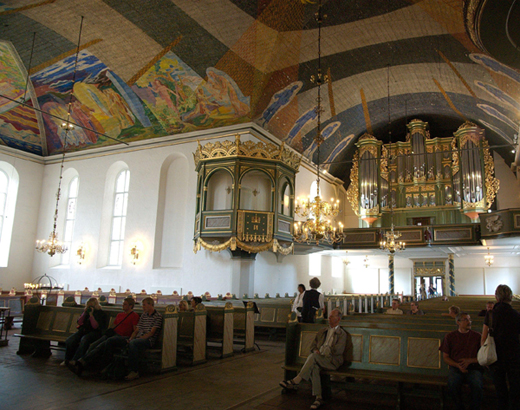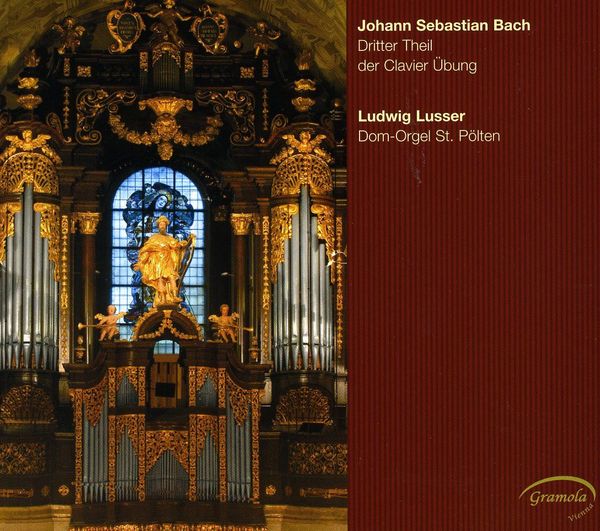 Norway Bach: Peter van Dijk (organ), Oslo Domkirke, 10.3.2012 (JFL)
Norway Bach: Peter van Dijk (organ), Oslo Domkirke, 10.3.2012 (JFL)
Bach: Clavier-Übung III (Selection)
Oslo Cathedral Main Organ, Ryde & Berg, Opus 39/1998

Most churches strive upward to point toward the heavens, if not outright try to touch them. Oslo’s main church, the red-brick Domkirke, stays notably earthbound. Squatting compactly in the centre of Oslo, two blocks from the central train station, it makes me wonder if Norway’s mid-19th century protestant ethic and aesthetic—that was when the 300 year old church was last re-built—would have deemed it unseemly to aspire to ambitiously to lofty heights. Or perhaps the architecture speaks more to a realism of statics than the Norwegian religio-aesthetic psyche.
Be that as it may, the Cathedral is central to the Oslo’s International Church Music Festival, which lasts from the 9th until the 18th of March. The festival is impressive in names and numbers: Seventeen performances in 10 days, four world premieres, and a list of performers that includes Peter Neumann, Grete Pederson and her Norske Solistkor, Le Concert Lorrain and the Nederlands Kamerkoor, Christoph Prégardien, Andreas Scholl, Dietrich Henschel, Ruth Ziesak et al.
The fourth concert of the festival was a late-night organ recital with Pieter van Dijk at said Domkirke on its modern main organ, a 1998 Jan Ryde-built instrument with 53 stops, over 4000 pipes, three manuals and pedal keyboard. On the bill: Clavierübung No.3.
Among the four so-titled keyboard exercises, only the third part is commonly known by this name*. And even then, Clavierübung III is probably still better known as the “German Organ Mass” (an Albert Schweitzer-given nickname). And perhaps better known yet is its opening and end, the Prelude and Fugue BWV522. English speaking Bach aficionados know it as the “St. Anne” Prelude & Fugue.
  J.S.Bach, Clavier-Übung, Part III, J.S.Bach, Clavier-Übung, Part III,Ludwig Lusser Gramola     |
In a way, Pieter van Dijk’s performance sounded like the Cathedral looks: stocky, short-legged, solid. He didn’t bound about, lyrically and lithe. And while that might not sound like a very flattering description, the gain of this approach was immediately notable. Van Dijk extracted all that stubborn, compelling rhythmical force from the Prelude, Fugue, and ten (out of 21) Chorale treatments that Clavierübung III contains. Different ears listen to Bach differently, no doubt; to mine there is nothing greater than to be carried forward, inevitably and inexorably, afloat on the sound… to literally breath in harmony with the music. Head-waggling and foot-tapping included. This is precisely what van Dijk achieved, aided and abetted by the gloriously symphonic, well balanced instrument that shines additionally with beautiful sounding reed pipes.
Not everyone will experience the same pacific, serene elation from this music (when well performed.) What will profoundly affect one listener (like this one), might not do much to the next. It is difficult to separate the flooding of the body and spirit with all that is good from the more sober reality of someone to whom Bach’s (organ) works are not the alpha and omega. It is easy, however, to suggest that anyone who has a strong inclination towards Bach, will have found this recital rewarding somewhere along these enthusiastic lines.
Jens F. Laurson
* The others are the Partitas (Clavierübung I), the French Overture together with the Italian Concerto (Clavierübung II), and the Goldberg Variations (Clavierübung IV).
